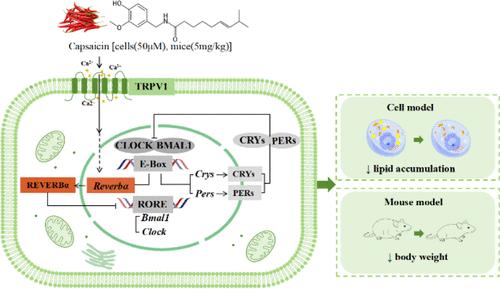Capsaicin Mitigates Reverbα-Involved Lipid Metabolism Disorder in HepG2 Cells and Obese Mice through a Trpv1-Dependent Mechanism
IF 6.2
1区 农林科学
Q1 AGRICULTURE, MULTIDISCIPLINARY
引用次数: 0
Abstract
Capsaicin (CAP), the active component of chili peppers, exerts a range of health benefits, including anti-inflammatory, antitumor, obesity-prevention, metabolic control, and biological rhythm-modulating effects, primarily through the activation of the transient receptor potential vanilloid 1 (TRPV1) receptor. The research explores the role of TRPV1 and its interaction with hepatic circadian clock regulation in modulating lipid metabolism and liver health. The effect of CAP on lipid metabolism and the potential mechanism was examined in HepG2 cells and high-fat, high-sugar diet (HFFD)-induced obese mice. In vitro, CAP (50 μM) decreased lipid droplet overaccumulation (from 152.8 ± 2.30 to 110.13 ± 3.91%), enhanced mitochondrial function (from 57.94 ± 1.93 to 86.74 ± 1.83%), and alleviated circadian desynchrony through a Trpv1-dependent mechanism in HepG2 cells. In vivo, CAP (5 mg/kg) reduced the body weight gain (from 50.61 ± 3.77 to 38.36 ± 2.04%), restored the hepatic circadian rhythm, and modulated the expression of lipid-related genes through the involvement of TRPV1 in mice. This study highlighted the potential of CAP to attenuate Reverbα-mediated lipid metabolic dysfunction through a Trpv1-dependent mechanism, revealing a complex interplay between circadian regulation and lipid metabolism.

辣椒素通过trpv1依赖机制减轻HepG2细胞和肥胖小鼠的reverb α-相关脂质代谢紊乱
辣椒素(Capsaicin, CAP)是辣椒中的活性成分,具有一系列的健康益处,包括抗炎、抗肿瘤、预防肥胖、代谢控制和生物节律调节作用,主要是通过激活瞬时受体电位香草样蛋白1 (TRPV1)受体。本研究探讨了TRPV1在调节脂质代谢和肝脏健康中的作用及其与肝脏生物钟调节的相互作用。在HepG2细胞和高脂高糖饮食(HFFD)诱导的肥胖小鼠中研究了CAP对脂质代谢的影响及其可能的机制。在体外,CAP (50 μM)降低了HepG2细胞的脂滴过度积累(从152.8±2.30降至110.13±3.91%),增强了线粒体功能(从57.94±1.93降至86.74±1.83%),并通过trpv1依赖机制缓解了HepG2细胞的昼夜节律不同步。在体内,CAP (5 mg/kg)降低小鼠体重增加(从50.61±3.77降至38.36±2.04%),恢复肝脏昼夜节律,并通过参与TRPV1调节脂质相关基因的表达。本研究强调了CAP通过trpv1依赖机制减弱reverb α介导的脂质代谢功能障碍的潜力,揭示了昼夜节律调节与脂质代谢之间的复杂相互作用。
本文章由计算机程序翻译,如有差异,请以英文原文为准。
求助全文
约1分钟内获得全文
求助全文
来源期刊
CiteScore
9.90
自引率
8.20%
发文量
1375
审稿时长
2.3 months
期刊介绍:
The Journal of Agricultural and Food Chemistry publishes high-quality, cutting edge original research representing complete studies and research advances dealing with the chemistry and biochemistry of agriculture and food. The Journal also encourages papers with chemistry and/or biochemistry as a major component combined with biological/sensory/nutritional/toxicological evaluation related to agriculture and/or food.

 求助内容:
求助内容: 应助结果提醒方式:
应助结果提醒方式:


